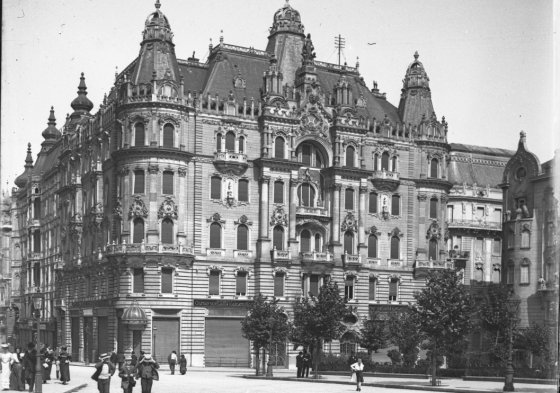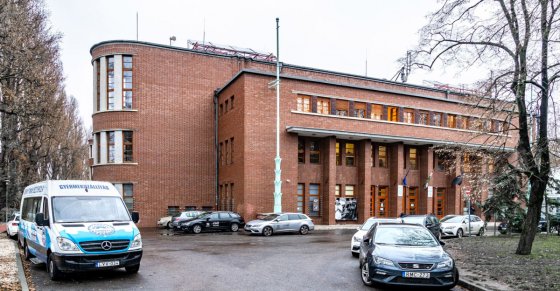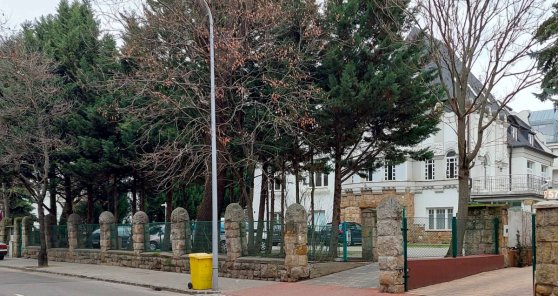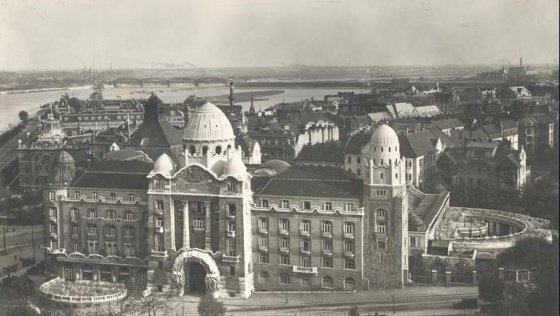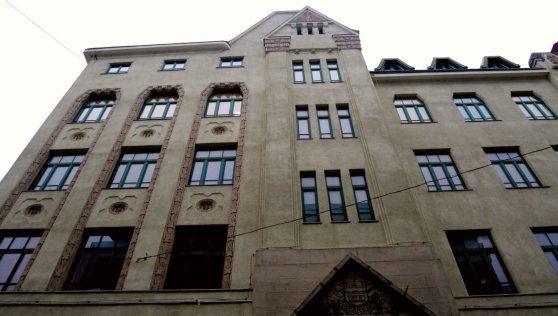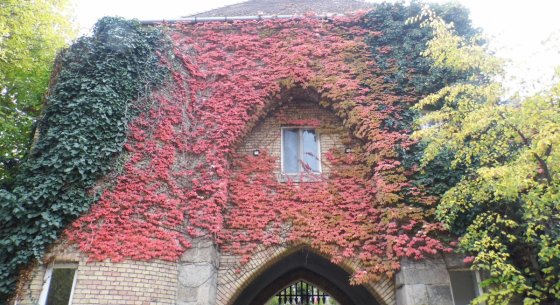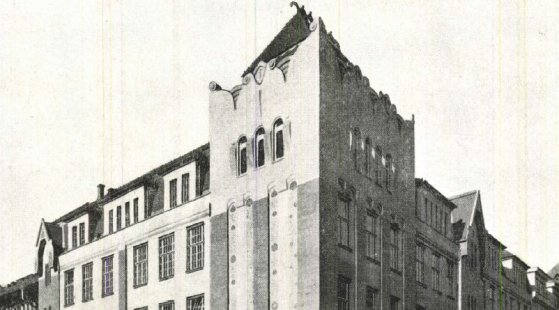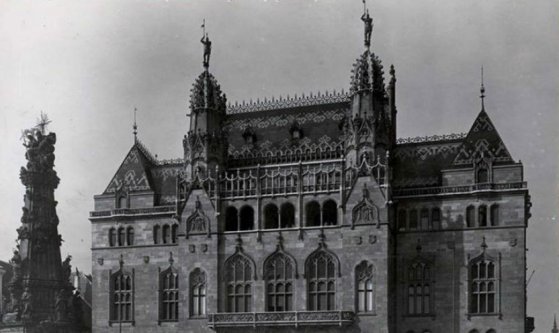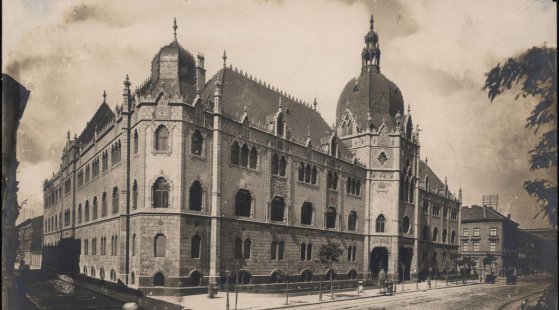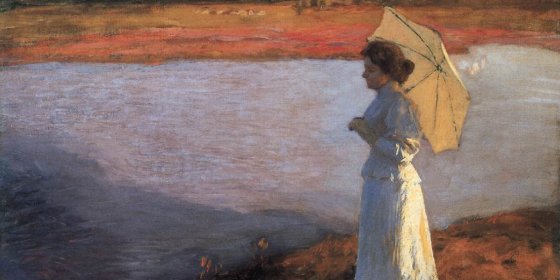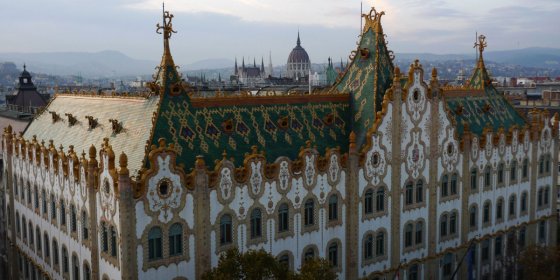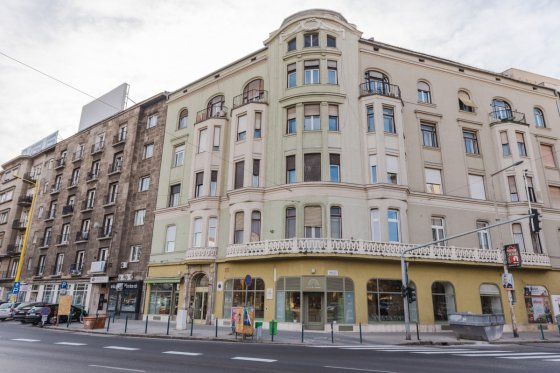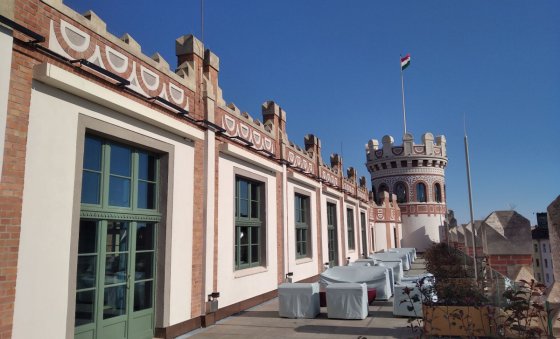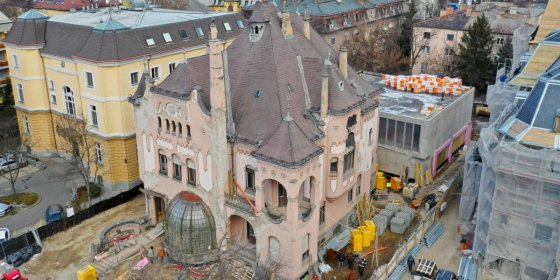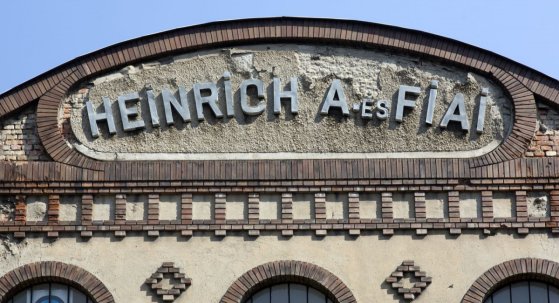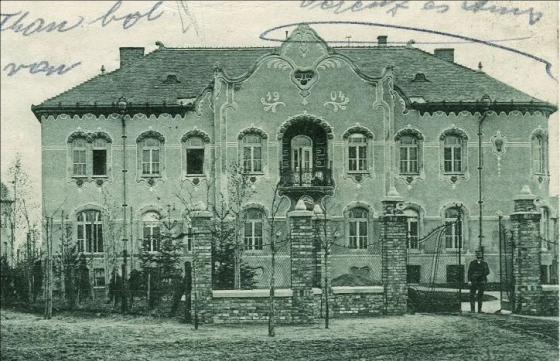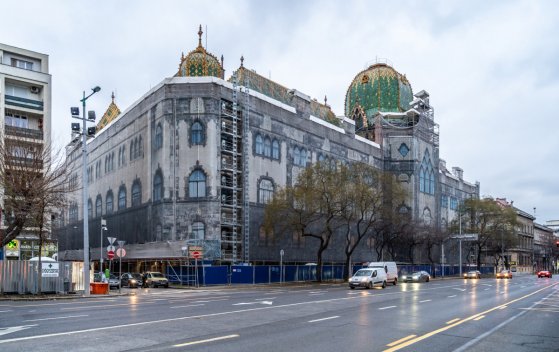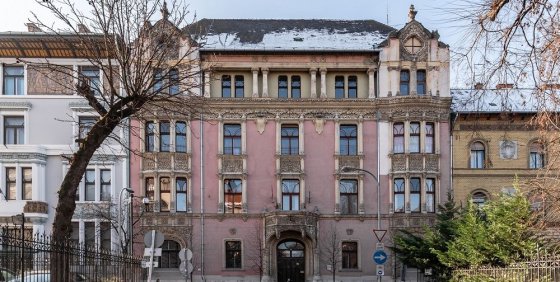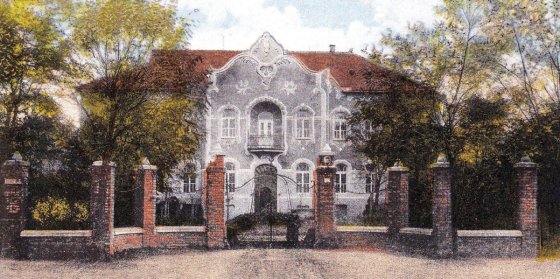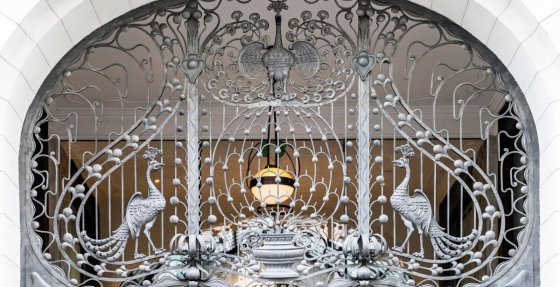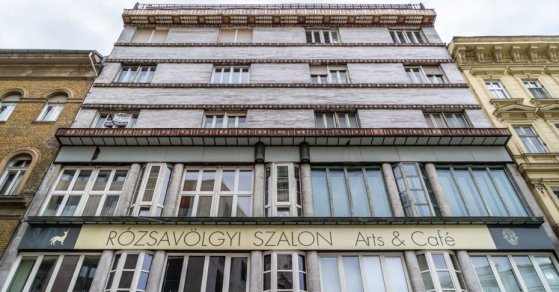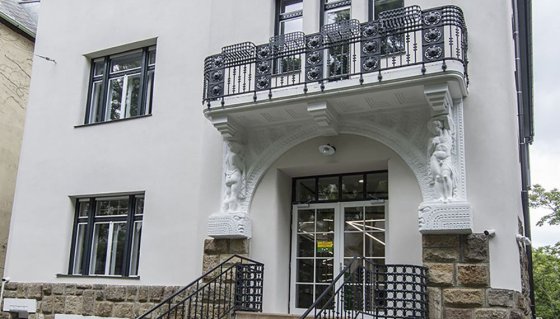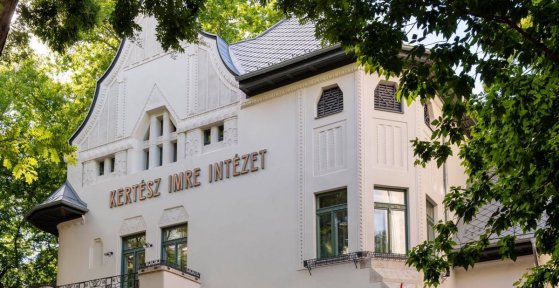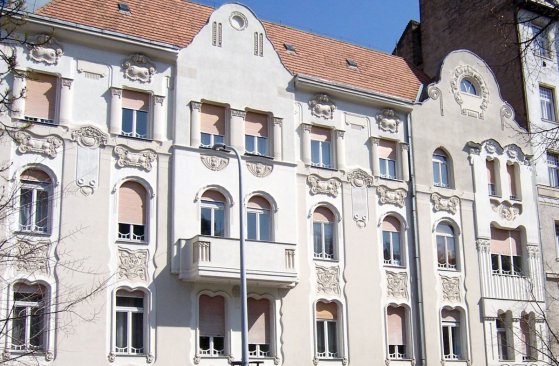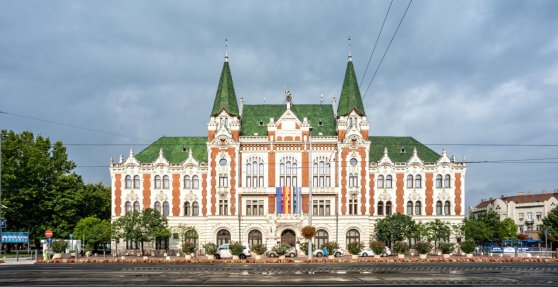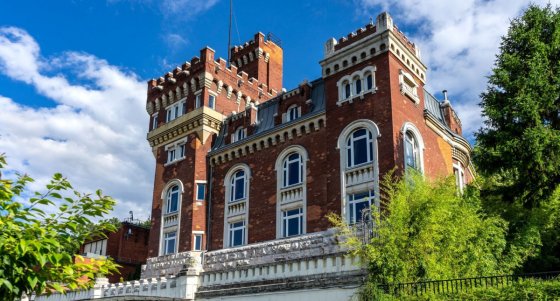 The „intertwined history” of the bridges and the city of Budapest
Which ideas and events have shaped the fate of bridges of Budapest and the cityscape? Alongside many other interesting facts, this question is also answered this newly published book by the Budapest City Archives, which introduces the history of bridges in Budapest.
The „intertwined history” of the bridges and the city of Budapest
Which ideas and events have shaped the fate of bridges of Budapest and the cityscape? Alongside many other interesting facts, this question is also answered this newly published book by the Budapest City Archives, which introduces the history of bridges in Budapest.
art nouveau
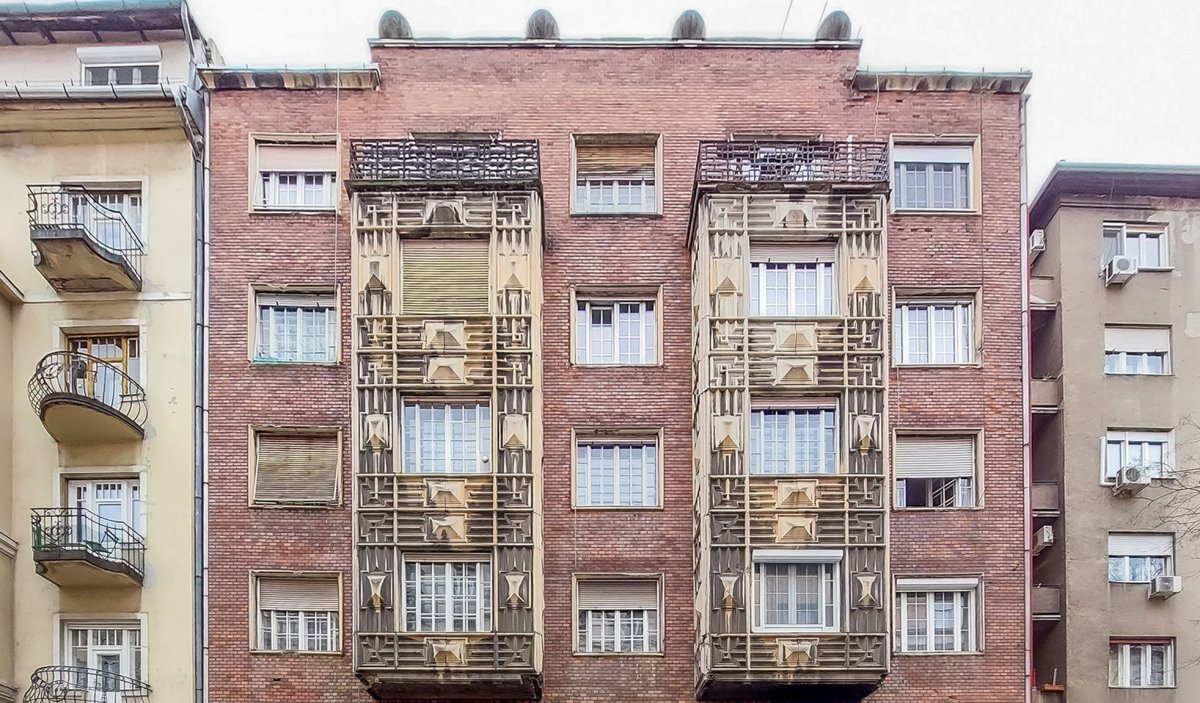 The small mirror of Art Deco - The lesser-known side of Frigyes Spiegel, who died 90 years ago
The small mirror of Art Deco - The lesser-known side of Frigyes Spiegel, who died 90 years ago
February 28, 2023 at 10:00 AM
Frigyes Spiegel wrote himself into the history of Hungarian architecture with his fantastic facades: his Art Nouveau buildings are the earliest appearances of the new style in the country. His genius naturally followed the changes of the times, and between the two world wars, he also left his mark on Art Deco - even if only to the extent of a single building. However, the historical circumstances also increase the value of this work of his, which also belongs to the elite in its category.
There was once a theatre in the Class Lottery Palace - The history of the theatre began 105 years ago on Eskü Square
February 12, 2023 at 9:00 AM
Where cars turn down today from the Erzsébet Bridge to the Pest embankment, before World War II, there stood a huge and beautiful building: the Class Lottery Palace. It was built at the turn of the century in the Neo-Baroque style, but Art Nouveau also left its mark on it. However, its interior was remodelled several times, most significantly for Vilma Medgyaszay's theatre. Jenő Lechner made its classicist plans in February 1918, exactly 105 years ago.
The first Hungarian Olympic champion became a famous architect - Alfréd Hajós was born 145 years ago
February 1, 2023 at 11:00 AM
Hungary is considered a great power in water sports, which was already foreshadowed by the glory of our first Olympic champion: Alfréd Hajós won Hungary's first gold in swimming. At the Athens competition, he was only eighteen years old, so he had to choose a career after his victory, and the swimmer nicknamed the Hungarian Dolphin became an architect. In the first half of the 20th century, Alfréd Hajós, who was born 145 years ago, achieved good results in this field as well, his works were of the high standard of the era.
Witnesses of an exciting era - A mix of styles on the turn of the century villas
January 27, 2023 at 9:00 AM
The term turn of the century usually refers to the end of the 1800s and the beginning of the 1900s, the last two decades of happy times of peace. This period brought amazing diversity to the field of architecture, which appeared not only in large-scale public buildings but also in smaller residential buildings and villas. An excellent example of this is provided by some early villas of a little-known architect, Jenő Lechner, several of which were taken over by their new owners in 1908, i.e., one hundred and fifteen years ago.
Who became a fan of Art Nouveau: the architectural legacy of Artúr Sebestyén, born 155 years ago
January 18, 2023 at 4:00 PM
Artúr Sebestyén, born 155 years ago today, was one of the important architects of the turn of the century. After graduating from the University of Technology, he worked in Alajos Hauszmann's office, his architectural work was initially defined by Neo-Baroque forms, then he increasingly turned his attention to Hungarian motifs. He designed many buildings in the capital, in the countryside and beyond the borders. His best-known work is the unmissable Art Nouveau creation, the Gellért Hotel and Thermal Bath.
A 110-year-old school building in Ferencváros - one of Albert Kálmán Kőrössy's masterpieces
December 1, 2022 at 9:00 AM
One of the large-scale masterpieces of Art Nouveau school architecture is bounded by three streets, Lenhossék, Vendel and Balázs Béla. Its main facade is so huge that people have to walk at least 50 metres away from it to admire its beauty. When it was completed, it stood out among the single-story houses in central Ferencváros. Nowadays, it is mostly surrounded by modern residential buildings, and perhaps there would be a residential building in its place too if it had not been given a new function a few years ago.
Art Nouveau on tombstones - An attempt to renew cemetery art
November 2, 2022 at 10:00 AM
Around the Day of the Dead, many of us visit the graves of our loved ones, and at this time we can discover that the cemetery is also a repository of real works of art. At the beginning of the 20th century, Art Nouveau, which broke with classical forms, permeated this area as well, and artists tried to offer new solutions to those who ordered tombstones. One of the most enthusiastic of them was the sculptor Richárd Füredi, who together with two of his colleagues organised an exhibition to introduce his works reflecting the new taste to the general public.
110-year-old neighbours - The twins of the big school building campaign
October 3, 2022 at 2:00 PM
Fortunately, there are many architecturally valuable school buildings in Budapest. A significant part of them was created in a very short period, in just three years: the Capital implemented a large school building program between 1909 and 1912. Many well-known alma maters were born at this time, but Pestbuda now presents two less famous examples of this fertile era.
French, Italian, German, Hungarian - The Royal Hungarian Ministry of Finance and its European counterparts
June 28, 2022 at 9:00 AM
Hungarian folk art played a major role in the magical interiors of the Szentháromság Square palace of the Hungarian Royal Ministry of Finance. Because at the time of its construction - at the very beginning of the 20th century - the national sentiment was on fire in our country, which was expressed in the language of architecture by reviving the people's ancient decorative motifs. A Ministry of Finance is an important institution in every country, but is the spirit of the given nation reflected on the walls elsewhere? By presenting some European examples, we are looking for the answer to whether this type of building was built based on this concept elsewhere.
Abundance of towers and reliefs - This is what the well-known tenement house on Károly Boulevard looked like
June 16, 2022 at 1:00 PM
In the huge tenement house in the centre of Pest, at the intersection of Károly Boulevard and Dohány Street, renovation works will soon begin: it will get its characteristic towers that were demolished after World War II. It is a building that is especially important from the cityscape point of view, and in addition to the interesting roof elements, there are also large reliefs on it. The huge facade of the house is a very high-quality work from the beginning of the 20th century.
World Art Nouveau Day is associated with Ödön Lechner
June 10, 2022 at 12:30 PM
We have been celebrating World Art Nouveau Day every year on 20 June, since 2013, at the initiative of Hungary. This day is associated with two famous architects of the turn of the century: Ödön Lechner (1914) and Antoni Gaudí (1926). The Museum of Applied Arts will be celebrated for two weeks, during which time it will present a number of Art Nouveau buildings in Budapest.
Béla Iványi-Grünwald, a popular figure in art life in Budapest, was born 155 years ago
May 16, 2022 at 12:00 PM
Among the innovators of Hungarian painting at the turn of the century, we consider Béla Iványi-Grünwald, who was born 155 years ago. He studied at the Mintarajziskola [Design School] on Andrássy Avenue, later becoming a popular and defining figure in Budapest's art life, one of the founders and core members of the Fészek Klub [Nest Club]. He is also the founder of the Nemzeti Szalon [National Salon], an association of artists dissatisfied with official art policy, with its headquarters in Erzsébet Square. When he died at János Hospital in 1940, his contemporaries said goodbye not only to a talented artist but also to an always cheerful social man.
Bees on the roof - The inner hall of the Postal Savings Bank is being renovated
April 25, 2022 at 9:00 AM
In the vicinity of Szabadság Square, the Postatakarékpénztár [Postal Savings Bank], which was built at the turn of the century, has been being renovated for months. In addition to Ödön Lechner's main work, three other works by the master are also being restored: the Museum of Applied Arts, the Balás Sipeki Villa next to the Városliget and the Drechsler Palace on Andrássy Avenue. While the latter are undergoing a larger-scale change visible from the outside, in the case of the Postal Savings Bank, its internal box office will get back its original dome. Once upon a time, this was also characterized by an imaginative ornamentation similar to the façade, but it was remodelled over time according to the needs of its use, but it was not spared by the storms of history.
The Single Parent Center opened in an Art Nouveau house in Buda
March 23, 2022 at 6:00 PM
The new Single Parent Center in Buda was set up in a beautiful Art Nouveau house on the ground floor of a former bank branch. The institution helping families opened its doors on Monday in the 12th district in the field of Hungarian Jacobins.
Stunning interiors - PestBuda visited the renovated Postal Palace
March 20, 2022 at 9:00 AM
The best-known building of Széll Kálmán Square is the former Buda Postal Palace, which has been dignified over the area since its handover in 1926. Hungarian Post (Magyar Posta) moved out of it in 2008, so it was empty for many years, it only found a customer in 2016. It was transferred to the Hungarian National Bank in 2018, and thanks to the reconstruction that began at that time, the building was reborn as the HNB Supervisory Centre and Money Museum. Huge changes have taken place, but they have been carried out with careful attention, and the interiors have been renewed in a way that also reflects the original states. PestBuda toured the renovated building.
The renovation of the Sipeki Balás villa designed by Ödön Lechner is progressing spectacularly, the new part of the building is ready for construction
February 4, 2022 at 7:00 PM
The complete reconstruction of the Art Nouveau villa, built between 1905 and 1907 on Hermina road, now the headquarters of the Hungarian National Association of the Blind and Visually Impaired (MVGYOSZ), began in the spring of 2021. Part of the work is the refurbishment of the roof, the renovation of the 2,700-square-meter plaster under restoration supervision, but the hall's unique fireplace and stairs, decorated with bluish eosin-glazed tiles, and the artificial stone elements of the façade, are regaining their old splendor. The new part of the building, which was demolished next to the villa and was erected on the site of an outbuilding in the 1970s, has already reached its finished state.
Two Faces of a Building - The Heinrich Courtyard in Józsefváros
January 26, 2022 at 10:30 AM
On the opposite side of Üllői Road, opposite the Museum of Applied Arts, stands a neo-baroque tenement house, built by the iron merchant Ferenc Heinrich. Not far from it, and in the neighbouring Mária Street, lies the long facade of an Art Nouveau warehouse. One would not even think that the two had anything to do with each other, however, both were built by the Heinrich iron merchant family. The latter was completed by 1912, meaning it could begin to be filled with goods a hundred and ten years ago.
Monument research on the Art Nouveau hospital building
September 10, 2021 at 9:30 AM
Most of the people living in the area still mention the North Pest Hospital as a former Russian hospital, whose buildings are located in Pestújhely, on a landscaped area of more than 7 hectares. The institution was originally built as a mental hospital in the Art Nouveau style. The plans for the renovation of the institution and the monument research were recently carried out by the owner, the 15th District Local Council.
The long-awaited reconstruction of the Museum of Applied Arts can begin
August 16, 2021 at 6:00 PM
During the works, the decorations of the beautiful Art Nouveau palace designed by Ödön Lechner will be restored inside and out, the foundation of the building will be strengthened, several internal partitions and courtyard annexes will be demolished, as well as the museum's 21-meter-high chimney.
A Master of Art Nouveau – Remembering Zoltán Bálint
March 11, 2021 at 11:00 AM
Zoltán Bálint was born 150 years ago and played a significant part in redefining Budapest's architecture, but his name is little known today. His prolific oeuvre, his work with fellow architect, Lajos Jámbor, elevates him to an unavoidable position in Hungarian Art Nouveau architecture.
Sanatorium, hospital and military installation – Art nouveau North Pest Hospital awaits rescue
February 9, 2021 at 10:00 AM
When completed in 1903, the North Pest Hospital – part of Pestújhely at the time – was the only Art Nouveau hospital complex in the country. Opening as the Niedermann Sanatorium, the building later housed a workers' hospital and then became a military complex used by occupying Soviet forces. It was used as the central health institution to serve soldiers stationed in Hungary. The Art Nouveau main building now provides specialist care for outpatients, but most of the more than thirty structures are unused, abandoned and dilapidated – despite nine of them being listed historical monuments.
A master of beautiful gates – Works by Gyula Jungfer adorn public buildings around Budapest
January 20, 2021 at 10:00 AM
A walk around the representative public buildings of Budapest is almost a walk to visit the major works on GyulaJungfer. The artist that reimagined ironworking in Hungary and elevated it to an applied art was born 180 years ago. His work still defines Budapest.
A forerunner of modern Hungarian architecture – Remembering Béla Lajta
October 28, 2020 at 9:00 AM
Lajta Béla was one of the most influential Hungarian architects of the first decades of the 20th century. Starting in the footsteps of Ödön Lechner, his art nouveau style grew into a new form and became a forerunner of Hungarian modern architecture. He represented a new approach to the formation of mass while retaining folk-based decorations and the ornamentation of art nouveau, and he connected it to new materials and designed buildings which were monumental in their simplicity. Buildings that have remained beautiful examples of modern urban architecture to the present day.
Art Nouveau meets the modern world – The final building planned by Albert Kőrössy Kálmán
October 1, 2020 at 11:00 AM
The renovation of the villa under 26 Benczúr Street was recently completed. The exterior designed by Albert Kálmán Kőrössy has remained an art nouveau villa, while the interior has become a modern space, equipped with state-of-the-art technology. Build as a residential building, it later became a language examination centre, and now houses a centre for education and innovation.
New headquarters of the Imre Kertész institute completed
September 16, 2020 at 9:00 AM
The renovation of the Art Nouveau palace under 46 Benczúr Street has been completed. The building will serve as the headquarters of the Imre Kertész Institute which manages the literary legacy of the Noble laureate, and János Sziveri, and parts of the legacies of Arthur Koestler, György Petri and János Pilinszky.
New Drug Research Centre to open next year in former hospital building
August 24, 2020 at 9:00 AM
The capital has few hospital buildings opened more than a hundred years ago that do not need to be thoroughly renovated, remodelled or modernised. There was also a period, not so long ago, when such institutions were closed rather than maintained. But the list of empty unused buildings also goes on and on, as they await new use of demolition. Fortunately, there are already examples of healthcare buildings being renovated without major changes in function. An example is the former Schöpf-Merei Ágoston Hospital.
Újpest City Hall 120 years old
August 22, 2020 at 9:00 AM
One of the symbols of Újpest, the town hall, which was inaugurated 120 years ago, on 21 August 1900, was designed by the outstanding architects of the age, Ármin Hegedűs and Henrik Böhm. Originally a town hall and then city hall from 1907, the historic building, which bears Art Nouveau features, is still in the service of the local population.
A little Genoa on Gellért Hill
July 21, 2020 at 11:00 AM
The Hegedüs Villa or originally the Schoch Villa is well known in Budapest, although few people know by its name. The mass of the building rises above the statue depicting Saint Gerard and the waterfall, so it is immediately noticeable when people drive from Pest to Buda across Erzsébet Bridge. Its medieval forms are less typical of early 20th century Hungarian architecture, according to urban legend, it is a copy of an Italian building. Pestbuda now reveals if the legend is true.
More articles
 The „intertwined history” of the bridges and the city of Budapest
Which ideas and events have shaped the fate of bridges of Budapest and the cityscape? Alongside many other interesting facts, this question is also answered this newly published book by the Budapest City Archives, which introduces the history of bridges in Budapest.
The „intertwined history” of the bridges and the city of Budapest
Which ideas and events have shaped the fate of bridges of Budapest and the cityscape? Alongside many other interesting facts, this question is also answered this newly published book by the Budapest City Archives, which introduces the history of bridges in Budapest.
 The Bridge Report, which brought a turning point in the history of Budapest
A travel report that changed the history of Pest and Buda, as well as Hungary. The little book contributed to the change of half a thousand years of legal customs and the implementation of an investment of unprecedented size and technical quality. This book was The Bridge Report [Hídjelentés in Hungarian].
The Bridge Report, which brought a turning point in the history of Budapest
A travel report that changed the history of Pest and Buda, as well as Hungary. The little book contributed to the change of half a thousand years of legal customs and the implementation of an investment of unprecedented size and technical quality. This book was The Bridge Report [Hídjelentés in Hungarian].
 Drama on the university wall - The heroic monument was planned 95 years ago
In the constant hustle and bustle of the Egyetem Square in Pest, the students may not even notice the monument that decorates the short section of wall between the church and the central building of ELTE. However, it commemorates their predecessors, the heroes who fought for their country in World War I, and those who heroically helped them. The first design of the dramatically collapsing soldier was born in 1928, ninety-five years ago.
Drama on the university wall - The heroic monument was planned 95 years ago
In the constant hustle and bustle of the Egyetem Square in Pest, the students may not even notice the monument that decorates the short section of wall between the church and the central building of ELTE. However, it commemorates their predecessors, the heroes who fought for their country in World War I, and those who heroically helped them. The first design of the dramatically collapsing soldier was born in 1928, ninety-five years ago.

